Monday, March 08, 2004
Concert 15, Saturday, March 6, 8:00 PM
by Guy Vollen
Saturday evening a visibly weary but proud Sam Magrill welcomed conference attendees back into UCO’s black box Pegasus Theater for the fifteenth and final concert of the SCI 2004 National Conference. Composer and pianist Anneliese Weibel began the program with her Three Songs after three short poems by Emily Dickinson, accompanying soprano Michelle McCall. “Bells,” ‘Vase” and “Mountains,” all restrained but expressive, were characterized by wide interval-spanning, sometimes jagged melodies and nuanced accompaniment.
Two more works were performed by their composers. Alto saxophonist Mark Engebretson presented his unaccompanied Energy Drink I, a technical tour de force in which growls, bends, altissimo, percussive tongue attacks and other extended techniques were brought together by a recurring rapid pulse. David Ward-Steinman then performed his Prisms and Reflections, a thoughtful, inventive work for piano (alternately employing prepared and conventional techniques) undertaken with seriousness and dramatic fire.
Baritone Robert Best and pianist Jeri-Mae G. Astolfi performed Phillip Schroeder’s mesmerizing Spirits of the Dead on Poems by Edgar Allen Poe, consisting of five songs connected by eerie interludes utilizing zither-like effects. Astolfi also interpreted Clifton Callender’s attractive, bebop-inspired character piece Patty, My Dear.
Five excerpts from Carl Sandburg’s Cornhuskers formed the basis of Robert Fleisher’s Prairie Songs, interpreted by soprano Emily Truckenbrod and pianist Amy I-Lin Cheng. From the subtly shifting “I was born on the prairie” to the angular and unsettling “I am here when the cities are gone” with its haunting refrain “I am dust of man,” this excellent cycle concluded with Truckenbrod’s transcendent delivery of “I speak of new cities and new people.”
Violist Sheila Browne closed the concert and the conference with a captivating performance of Kenneth Jacob’s Drifter’s Heart for Viola and Synthesized Sound. The attractive viola melodies combined with swirling and expansive additive-synthesized accompaniment and jangling bell sounds; a noodly middle section gave way to groovy syncopations and a hypnotic ending.
Concert 14, Saturday, March 6, 3:30 PM
by Guy Vollen
The second concert in the Jazz Lab was performed exclusively by the UCO faculty musicians of the Euphonious Saxophone Quartet. Soprano Earl Hefley, alto Marty Marks, tenor Lori Wooden and baritone Ron Howell presented four contrasting works with a tight sense of ensemble and bold sense of style.
Zae Munn’s jazzy, churning Hanging onto the Vine explored a shifting terrain of short interlocking patterns and thwarted harmonic expectations. Rapsodie des Ancêtres by Neil Flory kept up an active texture of independent, freely-developing motives until its serene ending.
Keith Carpenter remained close to a concept of the quartet as a rocking horn section in his Mission Creep, in which a recurring pulse of repeated notes branched into a variety of licks, keeping the momentum up almost until the end.
Carleton Macy’s Faust concluded the program with three sections (“Personae”). “Yearning” was characterized by a bold, robust opening and a keening soprano line amidst a welter of busy impressions; searching independent lines were heard throughout “Virtue and Anguish.” As for the third movement, if “Devil’s Play” is to be believed, then Mephistopheles is a pretty funky guy, his music marked by dissonant bell tones, squeaks, shrieks, and blatty bass lines, a play the Quartet could really have fun with.
Concert 13, Saturday March 6, 2:00 PM
by Guy Vollen
The University of Central Oklahoma Jazz Lab hosted this afternoon’s recital; the space offers a club-like ambience which fit many of the pieces performed. In a switch from the printed program, Frank Felice’s And So the Hole Was Dug was performed first by bassoonist Lori Wooden with electronic accompaniment. This witty and energetic work utilized spectral and spatial effects and diverse samples, including a Dr. Beat metronome and vocalized counting syllables.
“It was my songs that taught me all I know” was a claim made believable by baritone Kevin Eckard’s performance of four Tagore Songs by Stuart Hinds, accompanied by Samuel Magrill. The earnest, forward-moving melodies and dreamy piano part fit the text well, particularly in “Joy,” the second of
the set.
Charles Argersinger’s Seven Deadly Sins was dramatically performed by the trio of Hong Zhu (violin), Ralph Morris (viola) and Tess Remy-Schumacher (cello). The seven short movements were appropriately sinister-sounding and included some especially robust, singing cello lines that Remy-Schumacher made the most of.
This was followed by violinist Linda Hsu and pianist Stefanie C. Dickinson in a performance of Chihchun Chi-sun Lee’s quirky and imaginative Gin-á Koa, which made inventive use of Taiwanese children’s songs and techniques borrowed from Chinese performance practice. Janice Misurell-Mitchell performed her own Blooz Man/Poet Woman, a very effective piece of performance art from a composer who uses her extended flute technique and poetry to develop her own material.
Cellist Tess Remy-Schumacher threw herself bodily into her performance of Ilya Levinson’s Fantasy of Two Sols for Cello Solo, portraying a tremendous spiritual struggle through the work’s wide-ranging gestures.
The duo of flautist Christina Guenther and percussionist Dan Davis delivered a masterful performance of Laurence Sherr’s Duo Concertante, exploring a wide range of sounds and displaying dazzling virtuosity throughout the compelling work’s three movements.
Pursuing the Emerald Scintillate was the final composition on this program of pieces exploring cross-cultural themes and techniques. Although eschewing traditional eastern scales or instruments, composer Michael Timpson still evoked the commingling of ancient and modern with seven movements of enigmatic and bluesy, meditative and rocking music for the trio of alto saxophonist Jackie Lamar, violinist Linda Hsu and percussionist Blake Tyson.
Concert 12, Saturday, March 6, 10:00 AM
by Guy Vollen
The final day of the conference began in UCO’s Pegasus Theater with Two Piano Pieces by Daniel Powers. Performed by Martha Krasincan, “Silent Delight” and “Chorale” were unified by the composer’s choice of jazzy and impressionistic extended harmonies. The first resembled a classic-romantic andante with the “crunch” of contemporary harmony; the second began with an impression of remoteness but allowed expression to emerge in tasteful flourishes.
Krasincan was joined by clarinetist Michelle Coletta for Charles Norman Mason’s Sederos Que se Bifurcan, which began with a sprightly staccato opening; in an introspective middle section Coletta played into the undampered strings of the piano (a device that would have been more effective in a more resonant hall) before returning to the opening ideas and a bravura ending.
In Natalia mia for unaccompanied clarinet by Maria Elena Contreras, Chad Burrow displayed his warm, liquid tone in three movements that alternated bold gestures with subdued moments and rapid syncopated flourishes.
Burrow was accompanied by his wife pianist Amy I-Lin Cheng for Jason Scheufler’s Two Waltzes. “Satie” and “Jealous Lover” both consisted of evocative portraits, the former a gentle, winding melody referring to its namesake’s Gymnopedies and the latter an acerbic dialogue with a cabaret-like accompaniment and many flourishes and digressions.
Cheng then presented Howard Quilling’s technically-demanding Sonata for Piano #3, a three-movement cycle that featured among its many challenges a dialogue between conventionally-produced notes and tones plucked on the interior strings.
Gen’ei No Mai (“dances of illusion” or “fleeting visions”), by John G. Bilotta, was played with flair by flautist Katie Woods and clarinetist Kristin Knoble. A work of stylized grace, its five movements presented multifaceted, independent ideas and a finger-busting “Piu ritmico.”
After a pause, Jienee Moon performed J. Ryan Garber’s Resonances for Piano. Its three movements were unified by their technical challenge and dissonant language, leavened by warm chordal passages and exotic modalism, all leading to a conclusion brimming with raggy and funky cross-rhythms.
Two more works for clarinets concluded the program. Performed unaccompanied by Charya Wolfe, Jenni Shaffer Brandon’s Chanson de la Nature pour la Clarinette consisted of seven miniatures that captured their subjects with just a few brush strokes. The loping alternation between “La tortue et le lapin” (the tortoise and the hare) was instantly audible, and Brandon’s “Serpent” was more an elusive prankster than a sinuous tempter.
Finally, Mei-mi Lan’s Quartet for Clarinets consisted of two movements of effectively balanced solo and group gestures, including a number of jazzy, angular licks and the quartet’s use of mouthpieces alone.
Sunday, March 07, 2004
Pictures submitted by Linda Garrett
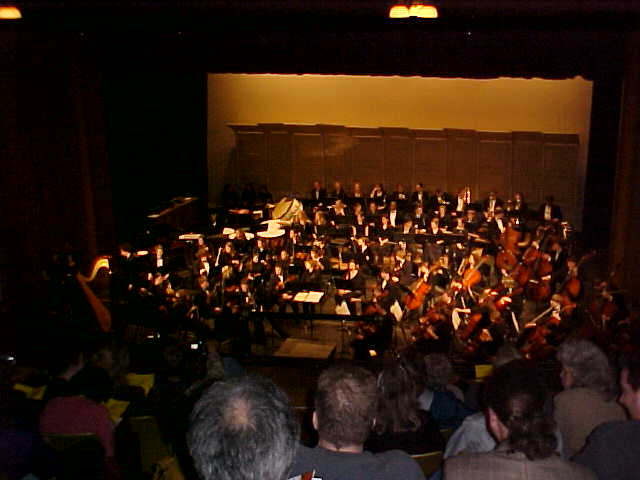
Oklahoma Youth Orchestra led by Director Dr. John Clinton
Performed Symphony of Alcoves by Zae Munn, Three Americans by Dr. Samuel Magrill, Serenity by John Lane, and Sarsen by Hilary Tann
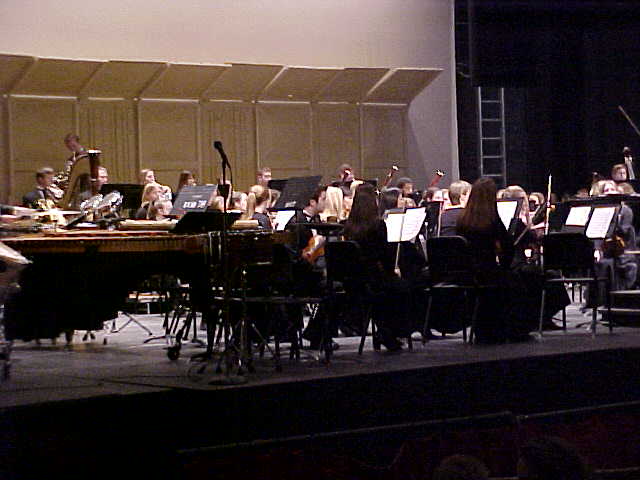
Oklahoma city University Sympony Orchestra led by Mark Parker
Performed Juba-Lee by Janice Misurrel-Mitchell, Winning Azaleas by Tayloe Harding, In loney Fields for Percussion and Orchestra by David Maslanka, and The Golden Spike by Ed Knight
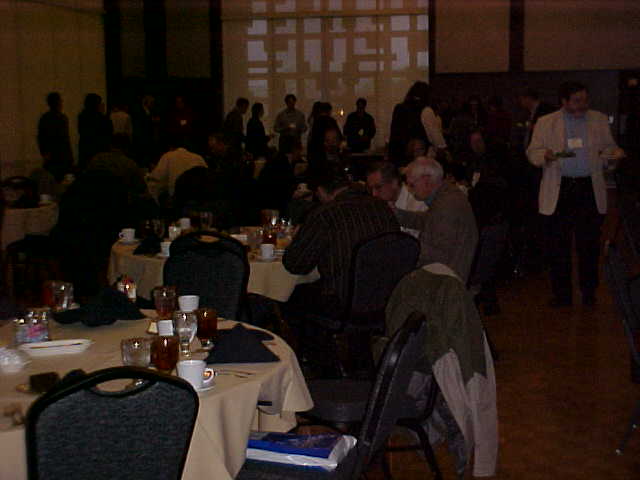
Composers and attendees at the dinner in the University of Central Oklahoma’s newly remodeled Ballroom.
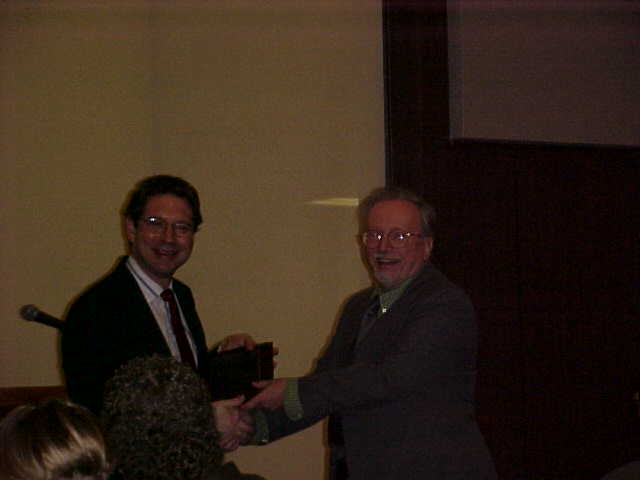
Dr. Samuel Magrill was given an award for hosting the conference.
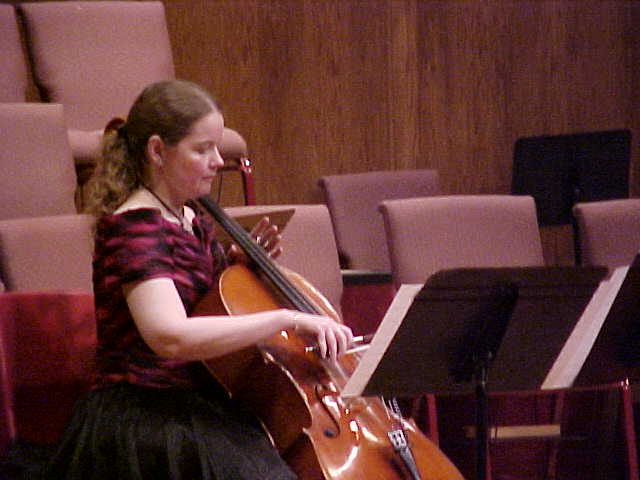
Tess Remy-Schumacher performed Wedding Braid for Cello Solo
Composer was Dr. Samuel Magrill
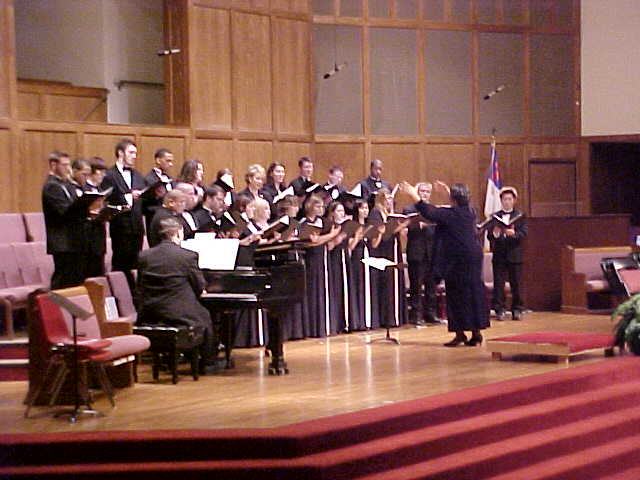
University Chorale led by director Sandra Thompson sand American Light (Composer Jason Haney) and Exaudi (Composer Frank LaRocca)
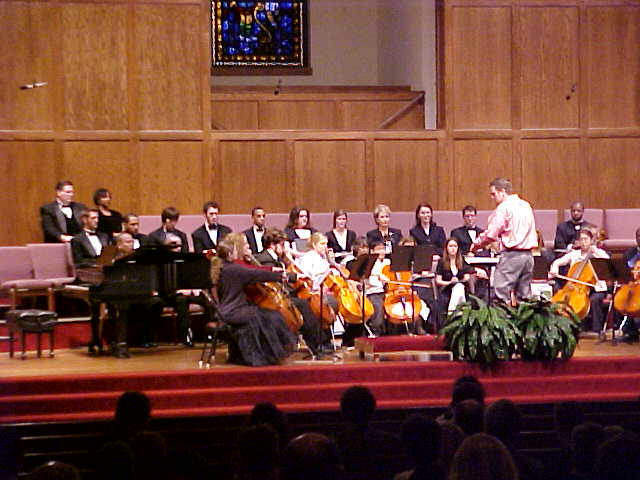
UCO Cello Ensemble under the direction of Tess Remy-Schumacher performed Shalom for Cello Ensemble (Composer Dr. Samuel Magrill)
Saturday, March 06, 2004
Concert 11, Friday March 5, 8:00pm.
by Guy Vollen
Following a banquet for conference attendees at UCO’s Nigh University Center, the group moved off campus for the Friday evening concert. Held in the warm (in acoustics and temperature!) and spacious sanctuary of the nearby First Christian Church, the concert included a variety of compositions for voices and strings.
Conference Host Samuel Magrill contributed two compositions for cello. Shalom was performed by the ten members of the UCO Cello Ensemble, conducted by conference attendee (and UCO alumnus Tom McCullough. Their performance revealed a work serious in tone, a combination of thoughtful melodic ideas and chromatic harmonies that slid stepwise into unexpected resolutions. Magrill’s Wedding Braid was played with relish by unaccompanied cellist Tess Remy-Schumacher. The soloist kept up with the rapid-fire juxtaposition of fragments from familiar wedding music, quickly changing character and technique to match each excerpt.
UCO’s University Chorale performed under the guidance of Director Sandra Thompson. Jason Haney’s American Light used unaccompanied voices to create a serene, soft glow, expressive but under control. Frank La Rocca’s Exaudi. featured dramatic contrasts in dynamics and the sudden emergence of pure triads from dissonant textures.
Cellist Remy-Schumacher returned to the stage to perform David Heinick’s Sonata for Cello and Piano, accompanied by Samuel Magrill. In three movements, the Sonata combined the technical with the expressive to great effect, particularly in the intricate arpeggiations and continuous rippling motion of the first movement (“Prelude”). Remy-Schumacher approached the final Scherzo with fire, lending a rougher tone to the wide-ranging, angular melodies.
Following a performance of Tom McCullough’s challenging Spinning Fix for String Quartet, the University Chorale returned to sing Craig Weston’s Credo. For this suitably anthemic work, characterized by unison lines diverging into seconds and wider intervals, the Chorale was joined by a string quartet and pianist Ron Wallace in unobtrusive supporting roles.
After an intermission, the men of the Chorale performed Greg Bartholomew’s folk-like A Country Boy in Winter, a poignant setting of nineteenth-century poem. The full University Chorale next sang the third movement of Jonathan Santore’s Untitled, a lively but smooth setting of South Korean poet So Chong Ju’s work.
Tess Remy-Schumacher and Samuel Magrill returned to perform Tony Raucci’s Variations and Interludes for Cello and Piano, an expansive set of connected sections. The composition began with an attractive lyrical theme and included a number of ingenious transformations, including a dream-like piano fantasia partnered with glistening harmonics in the cello part.
Two compositions by Becky Waters were performed by the University Chorale; the variation –like If There Is to Be Peace attractively and clearly set the thoughtful text, highlighting lush harmonies among the women’s voices in particular. For Waters regal-sounding Thou Art God the Chorale was joined by the accompanist Ron Wallace at the organ bringing the concert (and the day) to an impressive end.
Concert 10 Friday March 5, 3:30pm.
By Guy Vollen
Mark Parker directed the Oklahoma City University Symphony Orchestra in performances of four diverse works this afternoon in Mitchell Hall. The ensemble played with spirit and intensity beginning with Janice Misurell-Mitchell’s Juba-Lee. This eclectic composition began with a mysterious introduction spotlighting the flutes, and wound through a series of rhythmic developments to conclude with a bass-heavy syncopated dance.
Winning Azaleas by Tayloe Harding combined a contemporary triadic texture with a lively rhythmic approach (and more than a dash of high school football fight song) to paint an affectionate portrait of the composer’s home, Valdosta, Georgia.
David Maslanka contributed In Lonely Fields, a tour de force for seven solo percussionists and orchestra. Varying in texture from pointillistic dabs of color to full, unrestrained tutti, Maslanka’s work was by turns meditative, sorrowful, and triumphant and accepting, an elegy turned to encomium for a young musician.
Edward Knight’s The Golden Spike concluded the afternoon with a celebration of the Transcontinental Railroad and the laborers who made it a reality. This included evocations of Irish and Chinese folk music building up to a driving dance of celebration.
Concert 9, Friday March 5, 2:00pm.
by Guy Vollen
Four orchestral compositions graced the boards of Mitchell Hall Friday afternoon, led off by the University of Central Oklahoma Chamber Orchestra under dynamic conductor Hong Zhu. Stephen Yip’s Infinite Rain shimmered with veiled tone colors through the composer’s use of tremolo, string harmonics and sensitive scoring of his pentatonic melodies. The work, in three nearly continuous movements, ended on a forceful note with the insistent “Bells Ringing in the Rain.”
The UCO Symphony Orchestra performed three pieces. Arthur Gottschalk’s suitably cinematic Amelia(Empire of the Sun), dedicated to Amelia Earhart and her spirit of adventure, was directed by Lori Wooden. Its colorful scoring and ostinati suggesting alternating menace and heroism succeeded in building expectation into ever-higher waves of energy.
Amy Dunker’s intoxicating Mambo, also directed by Wooden, started out with the bang of “boiler room” Latin percussion and built to an exciting conclusion, graced along the way by hot solos from trombonist Chris White and trumpeter Jason Webb.
Ralph Morris concluded the program conducting Robert Hutchinson’s Jeux des Emfants, a warm and bright concoction full of infectious energy even in its softer, more introspective movements.
Concert 8 Friday March 5, 11:00am.
by Guy Vollen
The second concert of Friday morning featured the New Century Ensemble, the University of Oklahoma’s new music group directed by Christina Jennings. First, Kenneth Fuchs conducted his own composition, Quiet on the Land, a lyrical and pastoral work for flute (Jennings), oboe (Sally Faulconer), clarinet (Emily Wasson), viola (Matthew Dane) and cello (Gregory Sauer). This attractive piece was especially notable for the rich solo work of oboist Faulconer.
Two compositions for solo woodwind and electronics demonstrated contrasting approaches to the medium. Jeff Herriot’s Design for Bass Clarinet and Electronics, performed by Emily Wasson, relied almost exclusively on single tones, emerging from niente and receding back in combination with similar patterns in the electronics. The result was a subtle study of shifting colors. Mike McFerron’s Stationary Fronts started aggressively and never let up; here Jennings bravely pit her flute against rumbling electronic bass lines, synthesized percussion and altered flute samples. McFerron’s work gives life to the electronic as accompaniment, partner and contender.
Paradigm Shift, by Arthur Gottschalk, gave two violists (Dane and Arvilla Blochowiak) the opportunity to display their considerable skill in a daring caprice. A variety of technical passages executed in tandem at high speed marked this lively work.
Lastly, cellist Sauer joined pianist Christopher Hahn and percussionist Ricardo Souza in a fine performance of Jason Bahr’s cryptic omens…ritual echoes. Using a colorful palette of percussive effects, Bahr presented a series of dramatic and mysterious dialogues between the players.
Concert 7, Friday March 5, 10:00am.
by Guy Vollen
Friday morning began with clear skies and dry weather in Edmond. After a presentation by Lyn Liston of the American Music Center on the online New Music Jukebox, Jonathan Anderson’s Burke, Rawls, Harley began the program in Mitchell Hall. Clarinetist Michelle Coletta, violist Arvilla Blochowiak and pianist Samuel Magrill approached the first of two movements with a light touch, weaving nervous chromatic fragments into longer ideas.The second movement began with a lyrical solo from Blochowiak with unobtrusive accompaniment provided by Magrill; with the return of Coletta’s clarinet the trio returned to the active gestures of the beginning, ending with a flourish.
The three remaining works featured cellist (and University of Oklahoma associate professor) Greg Sauer. Sauer lent his warm, singing tone to Dana Richardson’s Preludes and Dances, marked by wide-ranging, introspective melodies beginning with an open-string motive in the first of three movements. The middle movement, labeled “Dance,” was especially notable for its athletic explorations of high and low registers and its quick syncopated rhythms.
Angel of Fire by Suzanne Sorkin was also unaccompanied, and Sauer made the most of this mysterious, almost ritualistic composition. Sorkin’s motto-like phrases, short at first but continuously lengthening and evolving, remained aloof throughout but suggested great passions just underneath the surface, straining for release.
Mr. Sauer was joined by pianist Howard Lubin for Laura Elise Schwendinger’s Rapture, a singular work that found Sauer reaching into ever-higher registers, as if to a transcendent goal barely out of reach. Together, both players contributed to a dramatic realization of the work that conveyed the mystery, hope and terror of its subject.
Friday, March 05, 2004
Concert 6, Thursday March 4, 8:30pm.
by Guy Vollen
On a program that also included stirring renditions of works by Grainger, Shostakovich and Philip Spark, conductor Brian Lamb led the UCO Wind Ensemble in performances of three compositions by conference attendees. Robert Hutchison’s Dancing on the Strand began the program with an energetic burst of muted trumpets, high woodwinds and mallet instruments. The piece as a whole was marked by complex interlocking rhythms and modal melodies accompanied by an ever-swirling and churning backup.
Samuel Magrill’s Tango Bandango, on the other hand, approached its subject in a respectful and traditional manner: for the most part, it is a tango, not a “tango.” Its discursive middle section and transitional material make it a symphonic example of its kind, however.
Finally, Rider by Bruce Hamilton pushed the UCO Wind Ensemble to the extremes of technique with its constantly shifting rhythmic patterns and diverse melodic ideas. One can hardly fault the composer’s invention, but the length of the work is such that a few islands of calm might be appreciated by the listener. Highlights included a dramatic oboe cadenza and dazzling percussion work.
Concert 5, Thursday March 4, 7:00pm.
By Guy Vollen
On Thursday night the Oklahoma Youth Orchestra, made up of talented high school students from around the state, performed three compositions by SCI composers. Under the direction of Dr. John Clinton, the program began with Zae Munn’s Symphony of Alcoves in three movements. Inspired by the architectural concept of “rooms within rooms,” Munn’s work employs motivic saturation and the dramatic build-up of repeated short phrases to create the sensation of waves of sound cresting and breaking.
Following John Lane’s Serenity, a touching and expressive duet for flute and harp (beautifully played by Mira Magrill and Shelley Du, respectively), the orchestra returned to perform Samuel Magrill’s Three Americans. Described by the composer as “an American Pictures at a Exhibition,” the three-movement piece is based on three paintings by Americans from UCO’s recently acquired Melton Legacy Collection, which conference attendees were able to view at a “sneak preview” reception earlier in the day. (Unfortunately, problems with a digital projector did not allow the images to be shown during the performance.) The composition began with a sense of sturm und drang, richly orchestrated and promising drama to come. The second movement, based on Chile Hassam’s, Still Life with Shells and a Bottle, featured highly expressionistic clusters and angular melodies, uneasily leading to a more conventionally romantic (but unresolved) ending. The final movement playfully showed off the composer’s carnivalesque side, combining a swinging 6/8 chanty with a serenade led by marimba and soli trumpets.
Massive and crackling with energy, Hilary Tann’s Sarsen was inspired by “standing stones”, both natural (as in the first movement, “Adirondacks) and placed by human hands (the other two sections, (“Sushou” and “Avebury”). Suffused with pentatonic melodies and wide intervals, the composition successfully evoked both the size and sweep of these monolithic landscapes.
Concert 4, Thursday, March 4, 2:30pm.
by Guy Vollen
UCO’s Pegasus Theatre rang with the sound of brass this afternoon in a program that concluded with the quiet hum of strings. James Klages began the afternoon with Jay C. Batzner’s Pioneer X for Unaccompanied Trumpet. The work, inspired by a space probe leaving the solar system, is marked by searching, open-ended melodies. During the course of the performance, Klages moved around the stage softening and eventually “disappearing” offstage.
Next was Will Gay Bottje’s Three of a Kind for Three Trumpets and Piano. Trumpeters Clint Rohr, Stephanie Matthews and Don Helm explored a variety of sound colors with the help of several different mutes and the composer’s structure of contrasting dynamics, registers and articulations. The trio’s parts included elements of marches, fanfare, ostinati and comments on the free-flowing piano part, ably played by conference host Samuel Magrill.
Two works were presented by the Liberace Brass Quintet, a combo of two trumpets and three trombones: Rondo Ostinato (Elegy for Z) by Jonathan Santore, and Images of the Southwest by Jim Stallings. Santore’s composition alternated a somber, blues-tinged opening with a jazzy, mixed-meter section, with a florid solo that the first trumpet player Jason Webb made the most of. Stallings’ Images presented four contrasting views of the desert, from the mysterious opening of “Earth and Sky” and the piercing, deadly beauty of “The Plains” to the big-band-inspired “In the City” and the austere grandeur of “Canyon Shadows.” The ensemble was tight and punchy, but kept the dynamic level just right for the small theatre.
The program concluded with the only non-brass work, Daniel Pertu’s Séance, masterfully performed by the UCO String Quartet. Séance presented a rich palette of string colors and characters, by turns brooding and agitated. Pertu resolved just enough tension to produce a soft, mysterious ending and a mood of mingled expectation and apprehension.
Concert 3- Thursday, March 4, 11:00 am
by Guy Vollen
With rains continuing to drench the UCO campus, conference host Dr. Sam Magrill gamely herded an army of wet composers and contemporary music fans into spacious Mitchell Hall for the third concert of the 2004 National Conference. Vocal compositions were prominent.
Michael Murray’s Five Blake Songs led off the program, an understated collection highlighting the warm middle registers of soprano Pamela Richman’s voice and Michelle Coletta’s clarinet. Soprano Marilyn Govich presented James Haine’s setting Four Whitman Songs, accompanied by pianist Richard Jobe. Set in a modern lyrical style, tonal but unafraid of dissonance, the Whitman Songs concluded with a timely treatment of the poet’s And Thou America that made full use of Ms. Govich’s sensuous vibrato and dynamic range.
William Vollinger’s The Child in the Hole was a setting of a different kind, a quasi-theatrical recreation of the true story of a Jewish child hidden underground for three years during the Holocaust. Soprano Pamela Green alternated between recitative-like narration and lyrical cris de couer, with clarinetist Ron Howell contributing an unobtrusive underscore and coming to the fore during several klezmer-inspired interludes.
Three instrumental compositions made up the rest of the program. The Least Among You, for four flutes (including one alto), was composed by Gregory Hoepfner and avoided the potential monotony of a uniform tone color by contrasting registers, textures and dynamics. Mark Francis’ Whetstone for Flute and Trumpet, consisting of four short sections, likewise balanced its two players by muting the trumpet much of the time and varying the two soloists’ relationship frequently. The final section effectively displayed the transformation of arpeggiated harmonies into broader melodic material.
The program concluded with Sabin Levi’s Nice Quodwind Wintette, a humoresque of dialogue-like interplay, unexpected punctuation in the form of sudden accents and stingers, and an irregular march at the end that, like the work’s title, turns the traditional woodwind quintet upside-down.
Concert 2- Thursday, March 4, 9:00am.
by Guy Vollen
A diverse collection of pieces was featured on Thursday morning’s recital in UCO’s intimate Pegasus Theater. Two solo pieces began the program: Cynthia Thompson performed AbiyoyOboe by Scott Robbins, accompanied by a world music-influenced electronic backup. Joseph Bognar followed, presenting Lego Dominatrix, a set of five toy-themed miniatures for piano by Stephen Wilcox. Written in a modernistic vein, the movements varied from the jumpy, high-register “Radio Flyer” to the rugged, fast-moving “Kung-Fu Grip.” The remaining solo work was Richard Zacharias’ Sonata # 1 for piano, gracefully rendered by Christopher Hahn, who overcame the tinny sound of the available instrument. A highlight of the Sonata was its attractive second movement with its folk-like pentatonic melody.
The remainder of the program consisted of Prime Etudes for Flute and Trombone, by James Haines, utilized prime numbers in the composition of its five movements, but to this reviewer the work might benefit from greater contrast within and between its movements. James A Jensen’s Variations and Theme on “Lullaby for Louise” presented a dramatic set, by turns melancholy and agitated. By presenting the theme last, it becomes an elegiac coda for the work, ably performed by violinist Jeffrey Z. Flaniken and pianist Donald C. Sanders.
Lee Hartman’s Song for a Tailor was the only vocal selection, with soprano Barbara Streets interpreting a Psalm-inspired text, accompanied by the subdued rolled chords of David Hardman’s marimba. Paul Dickinson’s Nine Pieces for a trio of flute, oboe, and clarinet posed an intricate challenge to the performers, who rose marvelously to the occasion. One notable element of this tightly-structured composition was a fast-moving, syncopated line, which was later treated as a canon three different ways.
Lastly, Ernesto Pellegrini’s DuologII for clarinet and piano was played, its performers having been delayed by the heavy rain. Their dramatic performance of the lush, chromatic piece showed no sign of hurry, however, bringing the recital to a fine end.
Concert I Wednesday, March 3, 7:30pm.
by Guy Vollen
It is fitting that the first concert of the 2004 National Conference of SCI should begin with a fanfare. Alla Scherzo by James Wiznerowicz, scored for twelve trumpets (four Virtuosi and eight supporting players), was confidently presented by the Trumpet Choir of the University of Central Oklahoma under the direction of James L. Klages. The composition featured intricate dovetailing of chromatic lines, weaving in and out of a cluster-dominated texture.
The rest of the program reflected the diversity of music being composed for wind and percussion ensembles. Two works for percussion combinations presented contrasting treatments: Karen McNeely’s Eve of Shadow and Light, while frequently rhythmic, derived much of its drama from the subtle interplay of castanets, wood blocks, and brushes, often at soft dynamic levels. The middle movement featured the duo of vibraphone and marimba, delicately playing off one another in a waltz-like dance. The second work, In the Mud at Toad Suck Park by Daniel Nass, was scored for timpani and a variety of indeterminate- pitch drums and cymbals. It presented sets of related rhythmic figures with varying degrees of emphasis, creating tension through dynamic and temporal shifts. Both compositions were directed with flair by David Hardman.
John Lampkins Migrations, performed by the UCO Symphonic Band under Brian Lamb’s direction, presented in its four movements both the ridiculous and the sublime of the natural world. “Salmon” began with short rhythmic patterns, the “stream” through which the salmon make their way, developing into a lyrical theme. “Red Crabs” and the final movement “Spiny Lobsters” emphasize the humorous side of their subjects, loosing a barrage of pungent and constantly varying tone colors and techniques, including key clicks, sound percussion (trash can lid cymbals, an auto horn) and an extended bassoon solo. The third movement “Broadwing Hawks” is lushly romantic, full of soaring melodies worthy of its title.
The final composition, again performed by the UCO Symphonic Band, led by Lori Wooden, was Luckie Street Grooves by Nickitas Demos. The two bravura solo parts were performed by Earl Hefley (clarinet) and Danny Vaughan (electric guitar). Although temporarily interrupted by an amplifier problem, the performance still revealed a vital score informed by jazz riffs, blues, rock, tango and funk. It was a fitting conclusion to an evening of conceptual and stylistic diversity.
Thursday, March 04, 2004
Pictures submitted by Linda Garrett
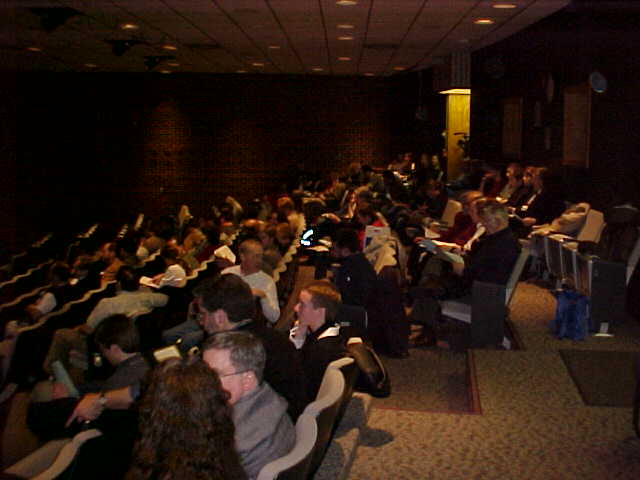
Attendees at Concert 4
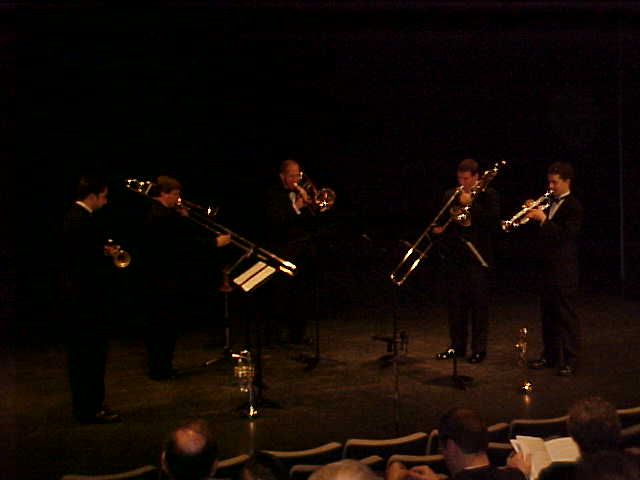
Liberace Brass Quintet performing Rondo Ostinato, Composer – Jonathan Santore
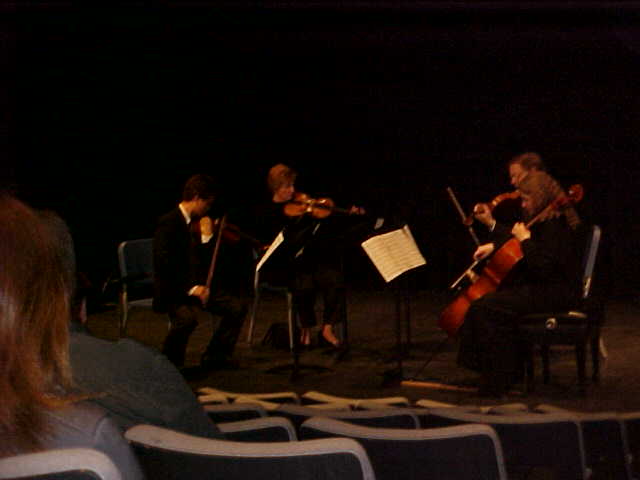
UCO String Quartet performing Seance, Composer – Daniel Perttu
SCI 2004 National Conference Event and Concert Schedule at a Glance
Wednesday, March 3
Concert 1 –7:30 P.M.
Mitchell Hall
UCO Trumpet Choir, James Klages, Director,
UCO Percussion Ensemble, David Hardman, Director,
UCO Symphonic Band, Lori Wooden, Director, Brian Lamb, Guest Conductor
James Wiznerowicz – Alla Scherzo
Karen McNeely – Eve of Shadow and Light
Daniel Nass – In the Mud at Toad Suck Park
James Curnow – Rejouissance
John Lampkin – Migrations
Nickitas Demos – Luckie Street Grooves
Reception after the concert in Evans Hall sponsored by the Edmond Arts and Humanities Council
Thursday, March 4
8 A.M.-5 P.M. Registration in the Faculty Lounge, Music Building
8 A.M.-9 A.M. Continental Breakfast in the Faculty Lounge, Music Building sponsored by SAI
Concert 2 –9:00 A.M.
Pegasus Theater
Scott Robbins – AbiyoyOboe
Stephen Wilcox – Lego Dominatrix
James Haines – Prime Etudes for Flute and Trombone
Richard Zacharias – Sonata #1 for Piano
James Jensen – Variations and Theme on “Lullaby for Louise”
Lee Hartman – Song for Tailor
Ernesto Pellegrini – Duolog II
Paul Dickinson – Nine Pieces for Woodwind Trio
Concert 3 –11:00 A.M.
Mitchell Hall
Michael Murray – Five Blake Songs
Gregory Hoepfner – The Least Among You
James Haines – Four Whitman Songs
Mark Francis – Whetstone for Flute and Trumpet
William Vollinger – The Child in the Hole
Sabin Levi – Nice Quodwind Wintette
Concert 4 –2:30 P.M.
Pegasus Theater
UCO Trumpets, the Liberace Brass Quintet and the UCO String Quartet
Jay C. Batzner – Pioneer X for unaccompanied trumpet
Will Gay Bottje – Three of a Kind for Three Trumpets and Piano
Jonathan Santore – Rondo Ostinato
Jim Stallings – Images of the Southwest
Daniel Perttu – Séance
5:00 P.M.-6:50 P.M. Sneak Preview of the Melton Art Collection in the UCO Art Gallery
(Official Opening on April 22)
Concert 5 –7:00 P.M.
Mitchell Hall
Oklahoma Youth Orchestra, John Clinton, Director
Zae Munn – Symphony of Alcoves
Samuel Magrill – Three Americans
John Lane – Serenity
Hilary Tann – Sarsen
Concert 6 –8:30 P.M.
Mitchell Hall
UCO Wind Ensemble, Brian Lamb, Director
Robert Hutchinson – Dancing on the Strand
Samuel Magrill – Tango Bandango
Bruce Hamilton – Rider
Percy Aldridge Grainger – Australian Up-Country Tune
Percy Aldridge Grainger – The “Gumsuckers ” March
Dmitri Shostakovich – The Tale of the Priest And his Servant Balda
Philip Sparke – Dance Movements
Reception after the concert in Evans Hall sponsored by the President Roger Webb
Friday, March 5
8 A.M.-5 P.M. Registration in the Faculty Lounge, Music Building
8 A.M.-9 A.M. Continental Breakfast in the Faculty Lounge, Music Building sponsored by SAI
9 A.M.-9:45 A.M. American Music Center Presentation: The New Music Jukebox, Lyn Liston, speaker
Mitchell Hall
Concert 7 –10:00 A.M.
Mitchell Hall
Greg Sauer, Cello
Jonathan Anderson – Burke, Rawls, Harley, trio for clarinet, viola and piano
Dana Richardson – Prelude and Dances for Cello Solo
Suzanne Sorkin – Angel of Fire for Cello Solo
Laura Elise Schwendinger – Rapture for Cello and Piano
Concert 8 –11:00 A.M.
Mitchell Hall
New Century Ensemble, Christina Jennings, Director
Kenneth Fuchs – Quiet on the Land for Flute, Clarinet, Oboe, Viola and Cello
Jeff Herriott – Design for Bass Clarinet and Electronics
Mike McFerron – Stationery Fronts
Arthur Gottschalk – Paradigm Shift
Jason Bahr – cryptic omens…ritual echoes
Concert 9 – 2:00 P.M.
Mitchell Hall
UCO Chamber Orchestra, Hong Zhu, Director
UCO Symphony Orchestra, Ralph Morris and Lori Wooden, Conductors
Stephen Yip – Infinite Rain
Arthur Gottschalk – Amelia
Amy Dunker – Mambo
Robert Hutchinson – Jeux des Enfants
Concert 10 –3:30 P.M.
Mitchell Hall
Oklahoma City University Symphony Orchestra, Mark Parker, Director
Janice Misurell-Mitchell – Juba-Lee
Tayloe Harding – Winning Azaleas
David Maslanka – In Lonely Fields for Percussion and Orchestra
Edward Knight – The Golden Spike
6:00 P.M. –7:30 P.M. Banquet at the University Center, Ballroom A
Concert 11 –8:00 P.M.
First Christian Church
University Chorale, Sandra Thompson, Director and Tess Remy-Schumacher, Cello
Samuel Magrill – Shalom for Cello Ensemble
Jason Haney – American Light
Frank LaRocca – Exaudi
David Heinick – Sonata for Cello and Piano
Thomas McCullough – Spinning Fix for String Quartet
Craig Weston – Credo
Greg Bartholomew – A Country Boy in Winter
Johnathan Santore – Untitled
Samuel Magrill – Wedding Braid for Cello Solo
Becky Waters – If There Is To Be Peace
Tony Raucci – Variations and Interludes for Cello and Piano
Becky Waters – Thou Art God
Saturday, March 6
8 A.M.-5 P.M. Registration in the Faculty Lounge, Music Building
8 A.M.-9 A.M. Continental Breakfast in the Faculty Lounge, Music Building sponsored by SAI
9 A.M.-10 A.M. FINALE 2004 Demonstration by Tom Johnson , Pegasus Theater
Concert 12 – 10:00 A.M.
Pegasus Theater
Daniel Powers – Two Piano Pieces
Charles Norman Mason – Sederos Que se Bifurcan
Maria Elena Contreras – Natalia mia for unaccompanied clarinet
Jason Scheufler – Two Waltzes for Clarinet and Piano
Howard Quilling- Sonata for Piano #3
John G. Bilotta – Gen’ei No Mai
Ryan Garber – Resonances for Piano
Jenni Shaffer Brandon – Chanson de la Nature pour la Clarinette
Mei-mi Lan – Quartet for Clarinets
12:00 NOON – 1:45 P.M. Business Lunch at Hideaway Pizza (next door to the UCO Jazz Lab)
Concert 13 –2:00 P.M.
UCO Jazz Lab
Ilya Levinson – Fantasy on Two Sols for Cello Solo
Stuart Hinds – Tagore Songs
Charles Argersinger – Seven Deadly Sins
Chihchun Chi-sun Lee – Gin-á Koa
Janice Misurell – Mitchell – Blooz Man/Poet Woman
Frank Felice – And So The Hole Was Dug
Laurence Sherr – Duo Concertante
Michael Timpson – Pursuing the Emerald Scintillate
Concert 14 –3:30 P.M.
UCO JazzLab
The Euphonious Sax Quartet
Zae Munn – Hanging onto the Vine
Neil Flory – Rapsodie de Ancêtres
Keith Carpenter – Mission Creep
Carleton Macy – Faust
Concert 15 – 8:00 P.M.
Pegasus Theater
Anneliese Weibel – Three Songs
Mark Engebretson – Energy Drink I
David Ward Steinman – Prisms and Reflections
Phillip Schroeder – Spirits of the Dead
Clifton Callender – Patty, My Dear
Robert Fleisher – Prairie Songs
Kenneth Jacobs – Drifter’s Heart
GetTogether at Bennigan’s after the concert

Follow Us